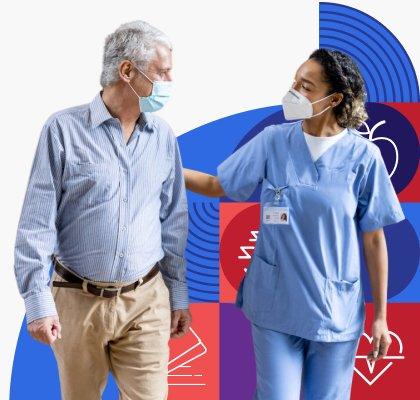Health Conditions
Talk with Your Doctor About Abdominal Aortic Aneurysm

The Basics
Overview
If you're a man age 65 to 75 years and have ever smoked, ask your doctor about getting screened (tested) for abdominal aortic aneurysm (AAA). Currently, routine screening isn’t recommended for women, or for men younger than 65 years or older than 75 years. But no matter what age or sex you are, consider talking to your doctor about AAA screening if you have a parent or sibling who had AAA. That’s because people with a close family member who had AAA may be at higher risk.
What is AAA?
The aorta is your body’s main artery. An artery is a blood vessel (or tube) that carries blood from your heart. The aorta carries blood from your heart to your abdomen, pelvis, and legs.
If the wall of your aorta is weak, it can start to bulge. This balloon-like bulge is called an aneurysm. AAA is an aneurysm that happens in the part of the aorta running through the abdomen.
Am I at risk for AAA?
Men over age 65 years who have smoked at any point in their lives have the highest risk of AAA. Both men and women can have AAA, but it's more common in men.
Other risk factors for AAA include:
- Smoking, both if you smoke now or you smoked in the past
- Family history — for example, if a parent or sibling had AAA
- Older age, especially age 65 years or older
- Being white
- Having other aneurysms, like thoracic aortic aneurysm (similar to AAA but in the chest instead of the abdomen)
- High blood pressure or high cholesterol
- Heart disease or vascular disease (problems with blood vessels)
Screening is recommended for all men age 65 to 75 years who have ever smoked. But some other people may benefit from screening, too — for example, women with a parent or sibling who had AAA. If you’re concerned about AAA, consider talking to your doctor about your risk. They can help you decide if screening is right for you.
Why do I need to talk to the doctor?
Aneurysms usually grow slowly without any symptoms. When aneurysms grow large enough to rupture (burst), they can cause dangerous bleeding inside the body that can lead to death. The aneurysm can also create a tear in the wall of the aorta, which is a serious problem, too.
If AAA is found early, doctors can treat it before it bursts. That’s why it’s so important to talk to your doctor about your risk.
Testing and Symptoms
How do I know if I have AAA?
To screen for AAA, your doctor may order an ultrasound. An ultrasound uses sound waves to look inside the body. The doctor or technician will use a wand-like device and move it over your body to see if there's any swelling in your aorta. Ultrasounds can be a little bit uncomfortable, but they don’t usually cause pain.
What are the symptoms of AAA?
AAA doesn't usually cause symptoms until it’s a medical emergency. Blood vessels like the aorta can bulge out slowly over time, so it’s important to talk with your doctor about AAA and your risk to see if you need to get tested.
Although most people with an AAA may not have any symptoms, some people may notice:
- Back pain
- A pulse you can feel near or below your belly button
- Dull ache or pain in the belly or side of your belly
When a AAA ruptures or starts to leak blood, it’s a medical emergency since blood loss from the aorta can lead to death. Some symptoms of a ruptured abdominal aortic aneurysm include:
- Sudden pain in your lower back, abdomen, or legs — usually the pain is severe
- Fast heart rate
- Low blood pressure
- Nausea (feeling like you're going to throw up) and vomiting (throwing up)
- Clammy (sweaty) skin
If you think you have a ruptured aneurysm, call 911 or have someone take you to the closest emergency room. You'll need to have life-saving surgery right away.
What does AAA look like?
Here's an example of what AAA looks like inside the body:
Take Action
Talk to Your Doctor
Take these steps to lower your risk for AAA.
Talk with your doctor about your risk for AAA.
Here are some questions you might want to ask your doctor or nurse:
- Do I need to get screened for AAA?
- How can I get help quitting smoking?
- What are my blood pressure and cholesterol numbers? Are they normal or high?
- What other steps can I take to keep my heart and blood vessels healthy?
Learn how to keep your heart healthy.
Be sure to tell your doctor if you have a close relative who had AAA, like a parent or sibling. Having a family history of AAA may raise your risk.
What about cost?
Under the Affordable Care Act, insurance plans must cover AAA screening for men age 65 to 75 years who have ever smoked. Depending on your insurance plan, you may be able to get screened at no cost to you. Check with your insurance company to find out more.
Medicare may also cover AAA screening for men ages 65 to 75 years who have ever smoked at no cost. If you have Medicare, learn about Medicare coverage for AAA screening.
If you don’t have insurance, you may still be able to get free or low-cost AAA screening. Find a health center near you and ask about AAA screening.
To learn more, check out these resources:
Keep Your Heart Healthy
Make healthy changes to lower your risk for heart problems.
It’s never too late to take steps to lower your risk for heart problems.
Quit smoking.
Quitting smoking is the most important thing you can do to lower your risk for AAA and other heart problems.
If you smoke, now’s the time to quit! Call 1-800-QUIT-NOW (1-800-784-8669) for free support.
Get your blood pressure checked.
If your blood pressure is high, you can help lower it by getting active, watching your weight, and eating less sodium (salt). Always check with your doctor to see if you need medicine to keep your blood pressure normal.
To learn more:
- Read about getting your blood pressure checked
- Use this list to help you shop for lower-sodium foods
- Learn how to prevent high blood pressure
Get your cholesterol checked.
If your cholesterol is high, start a heart-healthy eating plan. This means eating foods low in saturated fat and cholesterol. Always check with your doctor to see if you need medicine to keep your cholesterol normal.
Get the details about managing your cholesterol.
Get active.
Getting regular physical activity is another great way to support heart health. Aim for at least 150 minutes of moderate-intensity aerobic physical activity every week.
You can also:
- Check out these ways to add more activity to your day
- Use this planner to set activity goals and get tips to stay motivated
Eat healthy.
Choose a variety of fruits and vegetables, whole grains, chicken, fish, and low-fat dairy products. Try to limit saturated fats and sodium.
Content last updated September 17, 2024
Reviewer Information
This information on abdominal aortic aneurysm was adapted from materials from the National Heart, Lung, and Blood Institute.
Reviewed by:
Patrice Desvigne-Nickens, M.D.
Medical Officer, Heart Failure and Arrhythmia Branch
Division of Cardiovascular Sciences
National Heart, Lung, and Blood Institute



